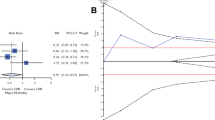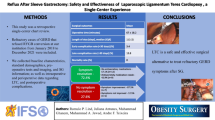Abstract
Background
The purpose of this study was to evaluate the safety and efficacy of endoscopic therapy, an alternative and less invasive modality for the management of leakage after gastrectomy.
Methods
An electronic database of 35 patients with anastomotic leaks after surgery for stomach cancer that were treated with either an endoscopic procedure or surgery between January 2004 and March 2012 was reviewed. The success rates and safety of both modalities were evaluated.
Results
Endoscopic treatment was performed in 20 patients and surgical treatment in 15 patients. The median time interval between the primary surgery and diagnosis of leakage was 8.0 days (interquartile range, 5.0–14.0 days). Of the 20 patients with endoscopic treatment, technical success was achieved in 19 patients (95 %) with resulting clinical success achieved in all of these 19 patients (100 %). One patient with failed endoscopic management went on to receive surgery. There were no cases of leakage-related deaths after endoscopic treatment. Of the 15 patients with surgical treatment, 5 died due to sepsis, bleeding, or hospital-acquired pneumonia. For diagnosis of leakage, 17 patients from the endoscopy group underwent computed tomography (CT) scanning, which revealed leakages in 3 patients (17.6 %) and occult leakages were subsequently defined at fluoroscopy in all 20 patients. Seven of twelve patients (58.3 %) from the surgical group had leakages diagnosed by CT scan.
Conclusions
Endoscopic treatment can be considered a valuable option for the management of postoperative anastomotic leakage with a high degree of technical feasibility and safety, particularly for leakages that are not excessively large.



Similar content being viewed by others
References
Alves A, Panis Y, Trancart D, Regimbeau JM, Pocard M, Valleur P (2002) Factors associated with clinically significant anastomotic leakage after large bowel resection: multivariate analysis of 707 patients. World J Surg 26:499–502
Urschel JD (1995) Esophagogastrostomy anastomotic leaks complicating esophagectomy: a review. Am J Surg 169:634–640
Gill RS, Whitlock KA, Mohamed R, Sarkhosh K, Birch DW, Karmali S (2012) The role of upper gastrointestinal endoscopy in treating postoperative complications in bariatric surgery. J Interv Gastroenterol 2:37–41
Higa KD, Boone KB, Ho T (2000) Complications of the laparoscopic Roux-en-Y gastric bypass: 1,040 patients—what have we learned? Obes Surg 10:509–513
See C, Carter PL, Elliott D, Mullenix P, Eggebroten W, Porter C, Watts D (2002) An institutional experience with laparoscopic gastric bypass complications seen in the first year compared with open gastric bypass complications during the same period. Am J Surg 183:533–538
Madan AK, Lanier B, Tichansky DS (2006) Laparoscopic repair of gastrointestinal leaks after laparoscopic gastric bypass. Am Surg 72:586–590; discussion 590–581
Wang Q, Liu ZS, Qian Q, Sun Q, Pan DY, He YM (2008) Treatment of upper gastrointestinal fistula and leakage with personal stage nutrition support. World J Gastroenterol 14:5073–5077
Oh SJ, Choi WB, Song J, Hyung WJ, Choi SH, Noh SH (2009) Complications requiring reoperation after gastrectomy for gastric cancer: 17 years experience in a single institute. J Gastrointest Surg 13:239–245
Karliczek A, Harlaar NJ, Zeebregts CJ, Wiggers T, Baas PC, van Dam GM (2009) Surgeons lack predictive accuracy for anastomotic leakage in gastrointestinal surgery. Int J Colorectal Dis 24:569–576
Lang H, Piso P, Stukenborg C, Raab R, Jahne J (2000) Management and results of proximal anastomotic leaks in a series of 1114 total gastrectomies for gastric carcinoma. Eur J Surg Oncol 26:168–171
Truong S, Bohm G, Klinge U, Stumpf M, Schumpelick V (2004) Results after endoscopic treatment of postoperative upper gastrointestinal fistulas and leaks using combined vicryl plug and fibrin glue. Surg Endosc 18:1105–1108
Raju GS (2009) Endoscopic closure of gastrointestinal leaks. Am J Gastroenterol 104:1315–1320
Pohl J, Borgulya M, Lorenz D, Ell C (2010) Endoscopic closure of postoperative esophageal leaks with a novel over-the-scope clip system. Endoscopy 42:757–759
Dai Y, Chopra SS, Kneif S, Hunerbein M (2011) Management of esophageal anastomotic leaks, perforations, and fistulae with self-expanding plastic stents. J Thorac Cardiovasc Surg 141:1213–1217
Bege T, Emungania O, Vitton V, Ah-Soune P, Nocca D, Noel P, Bradjanian S, Berdah SV, Brunet C, Grimaud JC, Barthet M (2011) An endoscopic strategy for management of anastomotic complications from bariatric surgery: a prospective study. Gastrointest Endosc 73:238–244
Nguyen NT, Rudersdorf PD, Smith BR, Reavis K, Nguyen XM, Stamos MJ (2011) Management of gastrointestinal leaks after minimally invasive esophagectomy: conventional treatments vs. endoscopic stenting. J Gastrointest Surg 15:1952–1960
Swinnen J, Eisendrath P, Rigaux J, Kahegeshe L, Lemmers A, Le Moine O, Deviere J (2011) Self-expandable metal stents for the treatment of benign upper GI leaks and perforations. Gastrointest Endosc 73:890–899
Bohm G, Mossdorf A, Klink C, Klinge U, Jansen M, Schumpelick V, Truong S (2010) Treatment algorithm for postoperative upper gastrointestinal fistulas and leaks using combined vicryl plug and fibrin glue. Endoscopy 42:599–602
Minami S, Gotoda T, Ono H, Oda I, Hamanaka H (2006) Complete endoscopic closure of gastric perforation induced by endoscopic resection of early gastric cancer using endoclips can prevent surgery (with video). Gastrointest Endosc 63:596–601
Sierzega M, Kolodziejczyk P, Kulig J (2010) Impact of anastomotic leakage on long-term survival after total gastrectomy for carcinoma of the stomach. Br J Surg 97:1035–1042
Lippert E, Klebl FH, Schweller F, Ott C, Gelbmann CM, Scholmerich J, Endlicher E, Kullmann F (2011) Fibrin glue in the endoscopic treatment of fistulae and anastomotic leakages of the gastrointestinal tract. Int J Colorectal Dis 26:303–311
Pross M, Manger T, Reinheckel T, Mirow L, Kunz D, Lippert H (2000) Endoscopic treatment of clinically symptomatic leaks of thoracic esophageal anastomoses. Gastrointest Endosc 51:73–76
Papavramidis ST, Eleftheriadis EE, Papavramidis TS, Kotzampassi KE, Gamvros OG (2004) Endoscopic management of gastrocutaneous fistula after bariatric surgery by using a fibrin sealant. Gastrointest Endosc 59:296–300
Chassin JL (1978) Esophagogastrectomy: data favoring end-to-side anastomosis. Ann Surg 188:22–27
Viste A, Eide GE, Søreide O (1987) Stomach cancer: a prospective study of anastomotic failure following total gastrectomy. Acta Chir Scand 153:303–306
Upponi S, Ganeshan A, D’Costa H, Betts M, Maynard N, Bungay H, Slater A (2008) Radiological detection of post-oesophagectomy anastomotic leak—a comparison between multidetector CT and fluoroscopy. Br J Radiol 81:545–548
Disclosures
Seohyun Lee, Ji Yong Ahn, Hwoon-Yong Jung, Jeong Hoon Lee, Kwi-Sook Choi, Do Hoon Kim, Kee Don Choi, Ho June Song, Gin Hyug Lee, Jin-Ho Kim, Beom Su Kim, Jeong Hwan Yook, Sung Tae Oh, Byung Sik Kim, and Seungbong Han have no conflicts of interest or financial ties to disclose.
Author information
Authors and Affiliations
Corresponding author
Additional information
Seohyun Lee and Ji Yong Ahn have contributed equally to this study.
Rights and permissions
About this article
Cite this article
Lee, S., Ahn, J.Y., Jung, HY. et al. Clinical outcomes of endoscopic and surgical management for postoperative upper gastrointestinal leakage. Surg Endosc 27, 4232–4240 (2013). https://doi.org/10.1007/s00464-013-3028-y
Received:
Accepted:
Published:
Issue Date:
DOI: https://doi.org/10.1007/s00464-013-3028-y




